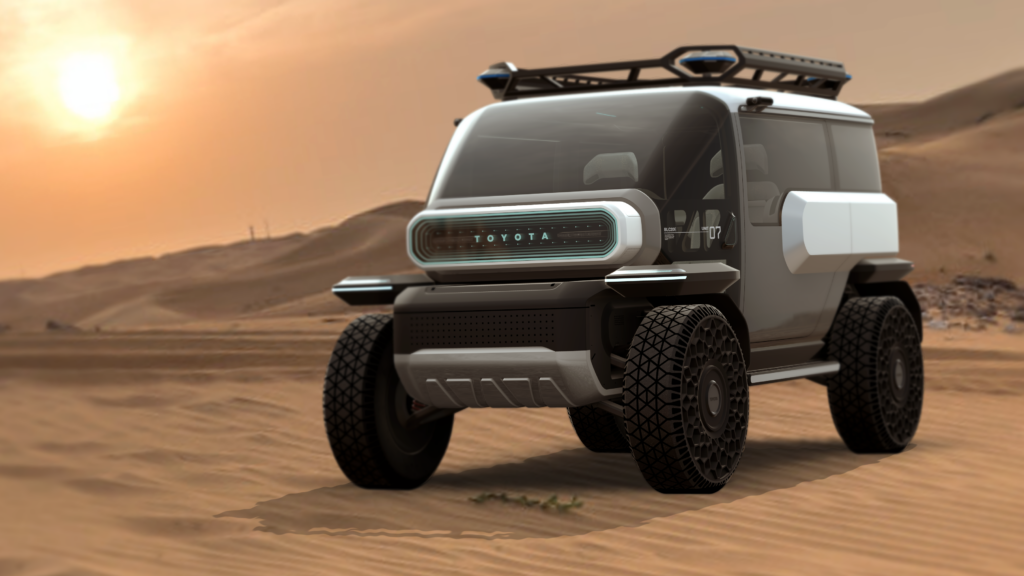Since its founding in 1973, Toyota has been at the forefront of creative automotive innovation. Thanks to the talented masterminds at Toyota’s design studios in California and Michigan, many of the company’s iconic and pioneering designs have ushered in a new era of mobility that drives people forward. Some projects are immediately put on the fast track to production, while others may remain in the archives.
Regardless of status, the ingenuity and brilliance behind the design or project shouldn’t be ignored. It’s never too late to celebrate innovation, and these models exemplify unprecedented excellence.
From a late 1980s future high-performance concept to the Baby Lunar Cruiser, the following never-before-seen designs and projects from CALTY Design Research (Calty) are worthy of recognition. Ultimately, these cutting-edge designs have helped pave the way for vehicles on the roads today, as well as served as inspiration for future designs.

Toward the end of the 1980s, the Calty team began picking up speed. They churned out one radical design study after another, with many of them taking the form of performance/sports cars.
The unique Future High Performance Concept, created in 1989 and pictured above, featured an engine that emerged from the body. With the ease of a button, the mid-mounted powerplant raised from the vehicle, providing a cooling effect while driving. Pretty sleek, right? Well, there’s more. The driver-side windshield of the two-cockpit design could be completely closed when parked. The 1980s was all about flash and flair, and this advanced concept was no exception.

Before the groundbreaking Prius and other electric vehicles (EVs) were commonplace on roads around the world, Calty produced this EV concept just so Toyota Motor Corporation could see what one could look like.
Their design? A compact, lightweight vehicle with excellent aerodynamic qualities that provided maximum driving efficiency. The nameless energy-efficient vehicle stood out thanks to its wind-cutting profile and thin tires. Ideal for small families, the two-door/2+2 layout was intended for city commuting.
With the introduction of various EVs from Toyota over the years, this car, despite being purely an advanced design study, was one of Calty’s first serious foray into the EV genre.

Following the introduction of the Scion FR-S, Calty was inspired to put the vehicle’s unique platform and package to further use — namely, the flat-4 engine and all-wheel drive.
Created in 2012 (and pictured above), this conceptual study – the X86D – essentially transformed the svelte coupe into a four-door shooting brake. The uniquely shaped backside is a standout, giving it a hot rod-like appearance when viewed from its profile and rear.
Mimicking the cockpit of a race car, the cabin was centered around the driver. The low nature of the boxer engine allowed for a low hood line, making the design look the part of a pure sports car.

Exploring future transportation trends in big cities was the inspiration behind this 2012 NYC Concept. An internal project, it featured several unique and innovative traits, including a “fence seat” for front passengers. Unfamiliar with this feature? You’re probably not alone.
In the NYC Concept, front-seat passengers leaned against a support in a unique semi-seated/standing position in the same manner they would lean against a wall or a fence, so instead of being properly seated, they stood nearly upright with their hips pressed against the supports.
This allowed them to attain the same eye level with pedestrians, which enhanced eye contact near crowded walkways. Plus, the tight rear seats folded down, providing ample space to haul things like sports equipment or a bicycle.
The NYC Concept’s distinctive vertical proportion made for an extremely compact footprint with good utility — ideal for navigating crowded, busy streets.

When looking to the year 2030 for a capable 4×4, Calty designers had their sights set on the Lunar Cruiser for inspiration. Why? Because it’s designed for driving missions on the surface of the moon, of course. The Calty team felt that its advanced technological features were the perfect model to jump-start the futuristic off-roader.
The Baby Lunar Cruiser (BLC) is built on a conceptual EV platform with in-wheel motors providing power to all four airless tires. What’s more, its body was designed from an engineer’s perspective, making every component of the BLC grounded in reason and functionality. Plus, “drive control” joysticks are used to steer the compact car and also operate the accelerator and brakes. The rear seats accommodate two adult passengers and offer a fold-down feature for additional cargo space.
What’s an SUV of the future without a self-driving function? Of course, the BLC delivers, but it also boasts an augmented reality-based “drivetainment” system whose gamification feature converts the vehicle into an interactive video game.
When drivers want to take full control, Toyota’s Mobility Teammate Concept becomes a handy copilot. It generates driving assistance and even offers best route suggestions — keeping drivers safe and on track to reach their destinations seamlessly. Plus, it provides steering, throttle and brake inputs when needed.
Thanks to this innovative AI system, not only can drivers perform like overland pros, but it also allows the BLC to accomplish tasks once thought impossible, such as detecting potentially hazardous terrain before it’s within sight and searching for new species in the area…things that can come in handy here on Earth and beyond.
It’s clear that continuous improvement is what fuels creativity at Toyota, and the mobility company is revved and ready for the future.
